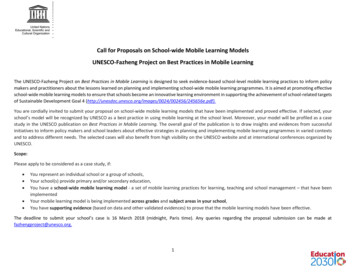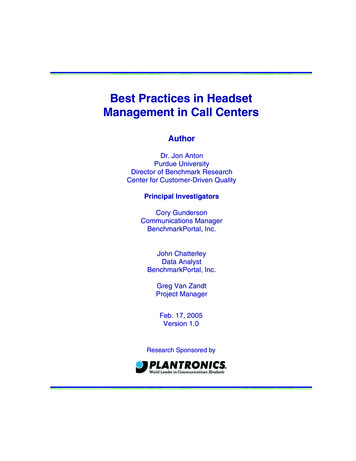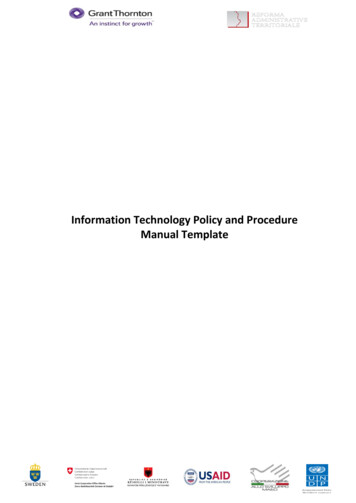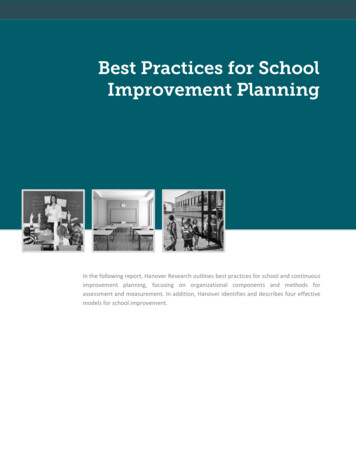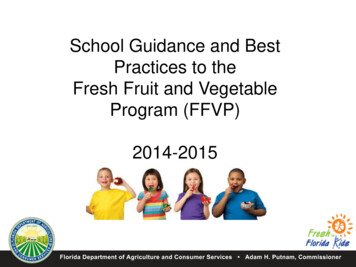
Transcription
School Guidance and BestPractices to theFresh Fruit and VegetableProgram (FFVP)2014-2015
WelcomeFFVP – School Guidance & Best Practices
GoalsThis is a United States Department ofAgriculture (USDA) program thatfocuses on creating healthier schoolenvironments by providing healthierfood choices, by: Expanding the variety of fruits andvegetables children experience; Increasing children’s fruit andvegetable consumption; and Making a difference in children’sdiets to impact their present andfuture health.FFVP – School Guidance & Best Practices
How To Be SuccessfulFFVP – School Guidance & Best Practices
Form a Team Team members should include:– principal– site cafeteria manager– teachers– school nurse– any other interested staffmembers and– parents volunteersAlthough the actual day-to-dayoperation will be the responsibility ofthe site cafeteria manager in themajority of sites, everyone has a role.FFVP – School Guidance & Best Practices
Process Planning (menu, budget, ge in schoolsMethods of distributionClean upClaim submissionFFVP – School Guidance & Best Practices
Potential Job Duties of FFVP Team Principal – oversee the FFVP team, ensure program guidelines are met,promote the FFVP throughout the school, ensure teachers are providingnutrition educationCafeteria Manager – order fruits, vegetable, and supplies, manage teacherrequests, oversee the budget at site level, prepare and deliver snacksCustodial staff – manage trash disposal and suppliesSchool nurse – provide nutrition education materials to food service staffand teachers, provide connections for learning between teacher lessonplans and FFVPTeachers – provide nutrition education in the classroom, act as a rolemodel by modeling healthy behaviorsMedia Specialist – conduct newscasts and coordinate information in schoolnews letterParent Involvement Specialist/PTA – act as a liaison between parents andschool, solicit parent volunteers in snack preparation and deliveryFFVP – School Guidance & Best Practices
Rollout of FFVP in Schools(Cannot use FFVP Funds) Suggest special event to introduceprogram to students, staff, parents, andmedia. Promote to staff at district pre-planning. Publicize through school or districtmedia. Provide parents with information bysetting up an FFVP table at Open House. Organize a special event with specialguest—high school students,cheerleaders, superintendent, mascots.FFVP – School Guidance & Best Practices
Fruits & VegetablesFFVP – School Guidance & Best Practices
Who Can Receive Fruits and Vegetables?(page10) All children who are enrolled at the school. Only teachers that are directly responsible forserving the fruit/vegetable to the students in aclassroom setting. Not intended for the general teacher population,other adults in the school, or community residents. FFVP cannot be used for gifts and rewards andcannot be withheld as part of a disciplineprocedure.FFVP – School Guidance & Best Practices
Best Times to Serve (page 12) Any time during the school day, except during breakfast and lunch. Serve once a day or during multiple times with some students served in the morningand some in the afternoon to maximize participation. When determining distribution, consider: grade level maturity of students time available to eat the fruits and vegetables time required for preparation and service of fresh fruits and vegetables extra clean-up garbage concerns staffing issues*All students must have access to the program, but a student has the option ofnot participating.FFVP – School Guidance & Best Practices
Best Places to Serve (pages12-13) ClassroomsIn hallwaysCentrally located kiosks can offer more choicesAs part of nutrition education activitiesOutside*Most successful distribution areas are places where children can easilyconsume the fruits/vegetables.FFVP – School Guidance & Best Practices
Delivery Teachers send count in the morning and produce is countedout in some type of marked container. Child nutrition staff count and place produce in markedbaskets, bins, bags, etc. Cafeteria is the most logical spot for central point for pick-up. Staff, volunteers, sometime the students, deliver toclassroom. Teacher distributes to students at optimal time and plans anNE lesson. Containers are returned to the cafeteria at the end of the dayfor sanitation and next-day preparation.FFVP – School Guidance & Best Practices
Unallowable items (page 14-15) Processed, canned, and frozen fruits andvegetables. Dried fruits or vegetables of any kind. Excess amounts of dips. Regular dressings or dips, peanut butter,hummus. Trail mix. Fruit or vegetables juices. Fruit that has added flavorings includingfruit that has been injected with flavorings. Smoothies. Fruit strips, fruit drops, fruit leather. Spices/seasoningsFFVP – School Guidance & Best Practices
FFVP Limits (page 15)Dips: Vegetables: Offer only low-fat, yogurt-based or other low-fatand fat-free dressings 1-2 tablespoons low-fat dips or dressingsallowed for vegetables only! Think creatively! Instead of serving lettuce,provide a lettuce and tomato with a light Italiandressing. Fruit: No dips of any kind allowedNote: “Prepared Vegetables”: Fresh vegetables (not canned,frozen, dried) can be cooked, but must be limited to once a week.FFVP – School Guidance & Best Practices
Serving Guidelines (page 16) Serve 2 or more times per week (reference your application). Purchase and serve more of your students’ favorites, but continue efforts tointroduce new items. Appealing and easy to grab. No specific portion size is required - consider the age of students. Suggestion is to provide ½ cup for portioned items or prebagged items. Serve different varieties of the same fruit (ie. Bartlett, Bosc, and Seckelpears) or vegetable (bell, sweet banana, and poblano peppers). Try “sample sizes” to introduce new items .FFVP – School Guidance & Best Practices
Leftovers/Cleanup (page 18) Extra items can be given to students who request extra.Increase portion size if always having leftovers.Those providing the FFVP may participate in the FFVP tasting.Plan for one day a week to serve leftovers. Provide a share table for leftovers after distribution to the children, preferablyat lunch as long as the students receiving the leftovers are part of the FFVPschool! Provide trash bags and disinfecting wipes for the classroom.*Share basket for teachers, nurses’ station, custodians, etc., cannot be provided.* Leftover’s cannot be taken home by anyone.FFVP – School Guidance & Best Practices
Nutrition EducationFFVP – School Guidance & Best Practices
Lessons (pages 20-21) Nutrition education lesson must be taughtduring the time of the FFVP “snacktime”Include whenever possible, even on daysthe program is not offered.Consult with FFVP partners to obtain nocost promotional items.Make teachers and administrators aware ofresources like: rematters.org/FFVP – School Guidance & Best Practices
Ideas (pages 20-21) Monthly/quarterly poster contests todecorate serving line and classrooms.Small white board featuring fruit orvegetable of the day on the serving line.Staff dresses up as fruit or vegetable.AM/PM announcements.Monthly menus sent to teachers andparents.Include information about the FFVP everymonth in school newsletter.Featured fruit of the month.Fact sheets.FFVP – School Guidance & Best Practices
Best PracticesFFVP – School Guidance & Best Practices
Suggestions Promotion and Nutrition Education Provide a display in the Main Office for parents and visitors Decorate your serving line with nutrition facts and information Fruit/Veggie mascots Maintain a display of FFVP nutrition information throughout the school year Decorate your line with nutrition facts and information Mapping of the fruit/vegetable (color, taste, texture, location, etc.) “My Favorite Healthy Snack” writing promptFFVP – School Guidance & Best Practices
ResourcesFFVP – School Guidance & Best Practices
Resources USDA FFVP HandbookTips for Administering the ProgramFlorida Harvesting CalendarProduction Record bookletI Tried It! stickers (1 roll)You may print these materials by downloading them from our website at:FDACS, FNW - FFVP webpageAdditional Resources:USDA FFVP websiteMyPlate MaterialsFruit and Vegetable Nutrition EducationFFVP – School Guidance & Best Practices
FFVP HandbookFFVP – School Guidance & Best Practices
Testimonials I had a parent tell me that their child had asked them to buy broccoli and dip at thegrocery store. the parent said the child would not eat vegetables and now he is eatingthem raw! Teachers and Staff: Please have your students notice all the posters in our diningroom. The are famous people made of fruit, vegetables, beans, etc. See if yourstudents recognize any of them Thank you so much for the snacks. The students are really learning aboutvegetables and fruit. They always look forward to the afternoon. I think it is going GREAT! I can’t wait to try the things the students have never had!You guys are doing an excellent job! My class loves it. It gives us an opportunity to talk about health and fitness. So farthey love the grapes, oranges, and apples. Not too many cared for the carrots but Imade them eat it anyways!FFVP – School Guidance & Best Practices
Contact InformationProgram QuestionsClaim QuestionsAimee Ashley850/617-7409Amy source LinksFDACS, FNW - FFVP webpageUSDA FFVP websiteFFVP – School Guidance & Best Practices
Thank you!FFVP – School Guidance & Best Practices
Small white board featuring fruit or vegetable of the day on the serving line. Staff dresses up as fruit or vegetable. AM/PM announcements. Monthly menus sent to teachers and parents. Include information about the FFVP every month in school newsletter. Fea


